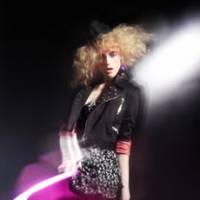Genki at Goocy
Goocy (pronounced "goosey") is the local answer to the Western "fast-fashion" invasion that has recently swept Japan. It's a pet project by brand director Harumi Fukuda and designer Mary Fukumoto of high-end label Triptych.
Along with quirky and fun clothing, Goocy shops are also one-stop souvenir shops, with a selection of eccentricities such as My Little Pony figurines and Sasquatch T-shirts. The two stores, in Harajuku and Shibuya Parco, provide a variety of price points, from ¥1,000 for accessories to a reasonable ¥30,000 for a leather biker jacket.
The latest batch of designs are based on the neon signs of 1980s Roppongi and are dedicated to those who like to live it up well into the night (or at least dress the part). You'll find miniskirts with splashes of neon, earrings shaped like lightning bolts and triangular patent-leather bags.
"They're not just shops, they're 'Super super stores!' " says Fukuda. Trust her: If you need any energy, you'll get a heaping, New Wave-inspired dose at Goocy. (Misha Janette)
The Goocy shop is at 4-26-23 Jingumae, Shibuya-ku, Tokyo ([03] 5771-2325) and in H PART-1 of Shibuya Parco.
Feeling blue for Green
At the end of the fashion show for Green's spring/summer 2009 collection, designers Yukiko Ode and Hideaki Yoshihara brought all key staff members on stage to give a teary-eyed bow. It was to be the final curtain call for the lauded Japanese brand as it is going on a hiatus due to Ode's recently announced pregnancy.
Green is one of Japan's top domestic brands, appearing at the nation's most exclusive boutiques and at super-hip shops across the globe. The aesthetic is sharp, cool and minimalist, with a base of military and futuristic designs. Ode and Yoshihara began the brand in January 1998 and opened the first Green shop in 2002, before unveiling a men's line in 2006.
The final collection is inspired by the 1960s sci-fi film "A Fantastic Voyage," which largely takes places inside a man's body. Patterns made of tendrils of hair and intestines, and crystals in a swirling DNA shape paid a chic homage to the curiosities of the human form. Pay your own respects quickly, as doors to its Ebisu boutique close in late June. (Misha Janette)
2-9-8 Ebisu-Nishi, Shibuya-ku; (03) 3780-1302
You, me and Gozi
Tokyo can be a fashion inspiration for designers around the world, but hardly ever do those designers plunge into the city's vortex by opting to move their operations to Japan. But Gozi Ochonogo from Nigeria did just that to start her promising new brand, U.Mi-1.
Gozi honed her design and patterning skills at the Central School of Fashion, London, which she graduated from in 2002. She then began a signature, eponymous line called Gozi, with which she quickly garnered enough interest to get a show on the Paris runways during the February 2004 fashion week.
After moving to Japan in 2006, Ochonogo began U.Mi-1 (pronounced "you, me, one") to create a fusion of the artistry of her new home country. Her third collection is mainly menswear and is based on the architecture of buildings in Tokyo's Aoyama district. Modern zigzagging seams and zippy details add a touch of Tokyo modernism to the casual attire.
U.Mi-1 also offers slim-cut suits for work, and eye-catching reworked denim bedecked with patches, pockets and paint. Most details are subtle but offer a chance to put on a piece of the metropolis. (Misha Janette)
For information, visit www.gozi.co.uk
What's next
Fashion-magazine junkies covet New Year magazines more than most due to editors' trend predictions and selections of must-buy items for the upcoming year.
SO-EN, the sister to Bunka Publishing's magazine High Fashion, puts out a special issue every January called the Newcomer's File. This indispensable edition from a fashion heavyweight — established in 1936, SO-EN holds the honor of being the nation's very first fashion magazine — introduces readers to the best new faces in genres such as styling, photography, brands, design, art and illustration.
This year the good folks at SO-EN have hand picked 18 such newcomers to populate an exhibition and store in the hip Harajuku art space Lapnet Ship. The event, which is free, runs from Jan. 16 to Feb. 22 and is an excellent opportunity to get your winter mittens on work from fresh faces, including brands PARADI and Deneb, design labels Kiwanda and MicroWorks (Shunsuke Umiyama) and illustrations from camiyama eri and Tomomi Sugiyama.
If you are out on a bargain-hunting spree at nearby Laforet and H&M, make it a priority to pop around to Lapnet Ship and have a peep at the names that are sure to dominate column inches in 2009. (Paul McInnes)
1-9-11 Jingumae 1F, Shibuya-ku, Tokyo; (03) 5411-3330
The Tiger's Zodiac
This year is the 60th anniversary of Japanese sports-fashion brand Onitsuka Tiger. Founded in Kobe by Kihachiro Onitsuka, it has grown from a domestic footwear company into an international brand creating a spectrum of fashionable shoes and apparel.
To celebrate the occasion, starting this month, the brand will present a special Zodiac collection in a staggered release. Based on the traditional Zodiac calendar, which features 12 animals and five physical elements, the theme will span the company's spring/summer and fall/winter campaigns.
Onitsuka Tiger has asked leading designers to graphically represent the Zodiac animals. For a spring/summer line, Takeshi Fukui has done an ox, rat and tiger, while Dutchman Erik Kriek takes on the snake, rabbit and dragon. The remaining animals will subsequently appear in the fall/winter campaign. A quirky animation based on the Zodiac will be available online in February. The colorful collection includes sneakers, T-shirts, track tops and short-sleeve shirts.
The 60th anniversary also sees the release of the Kanreki collection. Kanreki, the Japanese name for a 60th anniversary, is traditionally represented by the color red. Available from this month, this collection features celebratory red shoes (from label Mexico 66 Lauta), track tops and bags. (Paul McInnes)







